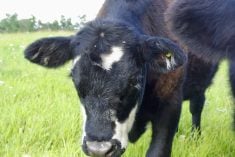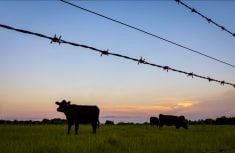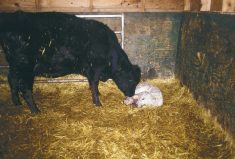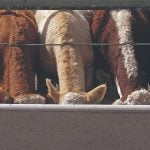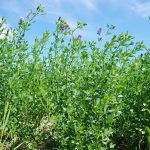Mycoplasma ovipneumoniae (M. ovi or Movi) is a respiratory pathogen associated with variable degrees of pneumonia in domestic sheep and goats. Movi first appeared in 1972 and has been on the list of respiratory diseases for sheep and goats since. Healthy bighorn sheep populations, originally naive to Movi, suffer severe outbreaks of mixed microbial pneumonia when exposed to Movi-infected domestic flocks. Chronic infection in recovered adults and subsequent transmission of Movi threatens the rate of lamb replacement. High mortality may signal loss of entire wild sheep populations despite valiant efforts of wildlife, government and volunteer organizations.
Read Also

The Canadian Cattle Association’s international advocacy efforts
Global ag policies affect Canadian food policy, so the Canadian Cattle Association participates in international and domestic forums
Ensuring the segregation of healthy bighorn sheep populations from Movi-infected reservoir hosts is crucial to prevent new disease outbreaks, but often unavoidable when the ranges of the two overlap. It may be possible to develop Movi vaccines, providing better and more effective management of domestic flocks. Targeted research would provide key epidemiological information thereby reducing the impact of this devastating disease on bighorn sheep and eliminating carriers in their domestic cousins.
Although considered a pathogen, Movi is a bacterial species commonly found in the nasal cavity and sinuses of apparently healthy sheep and goats. Pneumonia often appears because of other disease syndromes. Movi is transmitted to wild sheep and goats (bighorn sheep, thinhorn sheep and mountain goats) through nose-to-nose contact and, less commonly, aerosol/droplet transmission.
Thinhorn sheep are considered a subspecies of Dall sheep and are historically valued for the quality of their meat. In bighorn sheep, and very likely thinhorn sheep, Movi has been associated with large die-offs due to pneumonia. It affects all ages. According to wildlife researchers, die-offs are often followed by years of lower lamb birth and survival rates. Overall, Movi can have devastating effects on wild populations of sheep and goats. Presently, sound control efforts are inadequate because needed epidemiological information is missing.
READ MORE: Bighorn deaths attributed to sheep contacts
In many areas, especially along the east slope of the Rockies, interactions between domestic and wild populations occur throughout the year. These occurrences increase during times of wild sheep rut where the range of domestic sheep and wild flocks tend to overlap. Increasing popularity of packing into wilderness areas using goats as pack animals represents another opportunity for domestic stock to transmit Movi to wild populations. There are laws limiting packing goats to specific trails or banning them altogether in certain jurisdictions along the West Coast from Washington to Alaska.
Although Movi has been reported to affect species of Caprinae (sheep, goats and muskoxen), recent studies have identified the bacterium in species other than Caprinae, again demonstrating gaps in our basic knowledge of Movi. For example, Movi has been identified in Beira antelope (African species), caribou, moose, mule deer, white-tailed deer and domestic cattle. The prevalence and epidemiology of Movi are unknown for most of these species, especially white-tail and mule deer, which roam widely between domestic sheep flocks and cattle. With information missing about species’ susceptibility to disease, and which species might carry Movi commensally (mutual, non-threatening), transmission between species remains a big question mark. In the U.S., high death losses of bighorn sheep associated with Movi come with many questions including the role other respiratory pathogens played, such as lungworms (Protostrongylus species), Fusobacterium necophorum, Trueperella pyogenes and members of the Pasteurella bacterial family.
In 2011, a USDA National Animal Health Monitoring System study detected Movi by PCR test in one or more domestic sheep on 88.5 per cent (401/453) of sheep premises and 29.4 per cent (1,199/4,073) of individual sheep tested. An unpublished Alaskan study detected Movi in 57 per cent (4/7) of Alaskan domestic sheep premises and 7.6 per cent (13/171) of domestic sheep, which suggests that the prevalence varies significantly between regions.
Attempts by government wildlife agencies and volunteer groups to protect wild flocks from Mycoplasma ovipneumoniae include several untested initiatives and programs. Protecting these majestic animals remains an honourable goal, but difficult because so many pieces of the puzzle remain missing.
Advances in controlling the troubling realities of Movi in wild sheep and goat populations rest in a compilation of regulatory proposals sitting in books of government and volunteer factions in Washington state, Idaho, B.C. Alberta, Alaska, the U.S. Department of Agriculture and Canadian Food Inspection Agency. Key amongst them:
- Understanding the significance and threat of Mycoplasma ovipneumoniae in domestic flocks of sheep and goats, realignment of producer responsibilities and better assessment of conservation actions.
- Finding ways to ensure segregation of healthy bighorn sheep populations from Movi-infected reservoir hosts (crucial) including restriction of goats as “pack animals” where it makes sense to do so.
- Research on and development of effective Movi vaccines.
- Although epizootics and high death losses of bighorn sheep associated with Movi were first described in 2008, the epidemiology of this bacterium in bighorn sheep remains unclear. This must change.
- Ongoing support of groups like the Wild Sheep Society of British Columbia, the Western Association of Fish and Wildlife Agencies and the Wild Sheep Working Group Initiative.
- Acute change to the control and elimination of Movi from domestic flocks (test and cull, flock depopulation). The groups may want to open the book on Brucella elimination in Canadian cattle.







